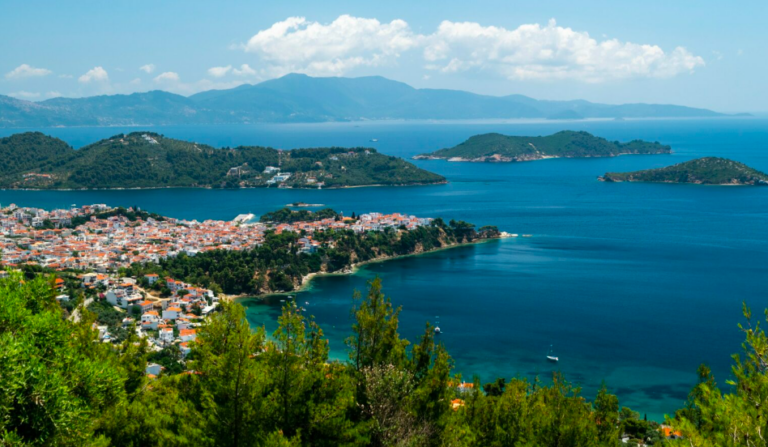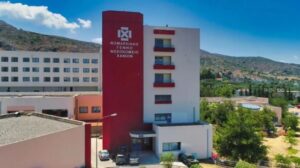The presentation of the new book, the tenth in a series by the indefatigable Giorgos Pittas, titled “And Everyone Ate and was blessed… The Gastronomy of Skiathos through the eyes of Papadiamantis,” was the occasion for an ex profundis “conversation” with the beautiful island, organized by the Municipality of Skiathos.
Pittas charmingly outlines the tastes, feasts, rural life cycle, and everyday simplicity of the island’s people, carefully selecting three hundred representative excerpts from ninety short stories by the eminent Skiathos writer Alexandros Papadiamantis (Armos publications). Through his chosen excerpts, Pittas highlights the island’s products and dishes, the café atmosphere, festivals, and the financial and commercial style of Skiathos society at the end of the 19th century. He explains why pasta is absent—grains were not cultivated—while many dishes combine seafood and fish with abundant vegetables. Even the term “shells” for shrimp, crayfish, and lobsters, which are low in meat, underscores the necessity of combining them with herbs and vegetables to enhance flavor.
The book launch occurred on June 1st, just behind Papadiamantis’ house in the small square bearing his name, making it one of the most beautiful book launches we’ve attended. Under the sprawling pine tree in the serene twilight, Bilio Tsoukala, the book’s editor, delivered the presentation. Journalist Nana Darioti, editorial director of the gastronomic magazine Cantina at Proto Thema newspaper, spoke about Pittas’ work, describing him as a solitary observer of culinary and social development in Skiathos over the years—an observer but not a participant, an ascetic in the world yet filled with love for it, akin to Papadiamantis.
George Pittas himself stated that upon completing the book, he felt transformed, having immersed himself in Papadiamantis’ humble and humane world. He highlighted the author’s unexpected humor, often acerbic, admiration for female beauty, and generous descriptions of his compatriots’ culinary delights. Matoula Chondronikoli, Deputy Mayor for Social Policy, warmly spoke of Papadiamantis, while Skiathos Mayor Thodoris Tzoumas summarized by asserting that “George Pittas reintroduces us to Papadiamantis, revealing the great through the simple, this time emphasizing the writer’s relationship with gastronomy (…). Our own purpose and responsibility are to preserve what inspired him—the places, nature, and unique beauty of Skiathos—and pass it on to future generations.”
During this exploration of Skiathos’ unique beauty, the mayor and his colleagues guided us through the island’s landmarks, intertwined with the suffering, joy, deprivation, lethargy, and heroic deeds of Papadiamantis’ literary figures. This three-day event provided insight beyond the island’s often bustling cosmopolitanism, luxury hotels, and vibrant nightlife, reintroducing us to the subtle Papadiamantis, barely visible amidst Chora’s crowded alleys. It immersed us in Papadiamanteios’ quiet, reverential world, empathetic towards the humble and lost, while also showcasing modern Skiathos’ efforts to attract a cultural, nature-loving, and gastronomically inclined audience.
For an enchanting weekend on Skiathos, follow the routes mapped out by the Municipality of Skiathos, with the spirit of Papadiamantis as your guide, ensuring your enjoyment and enlightenment.
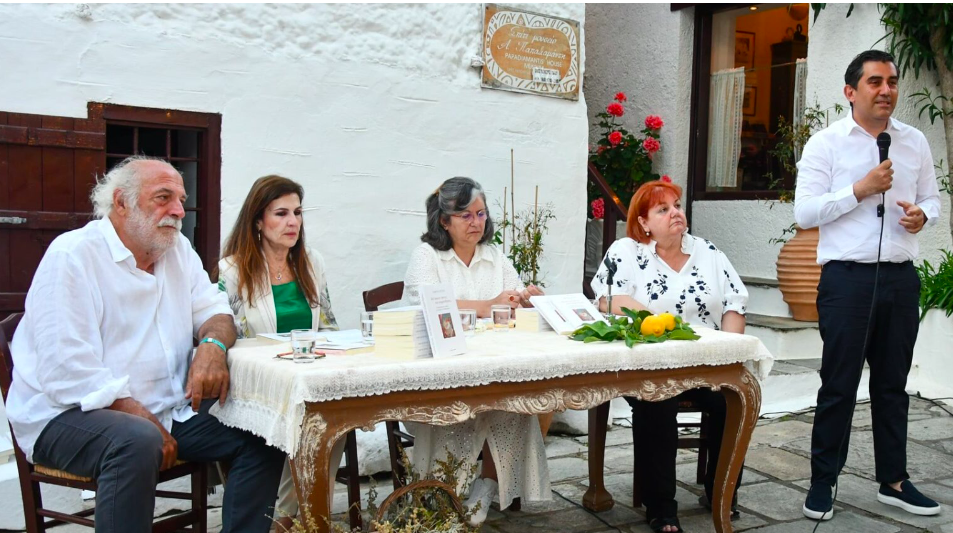
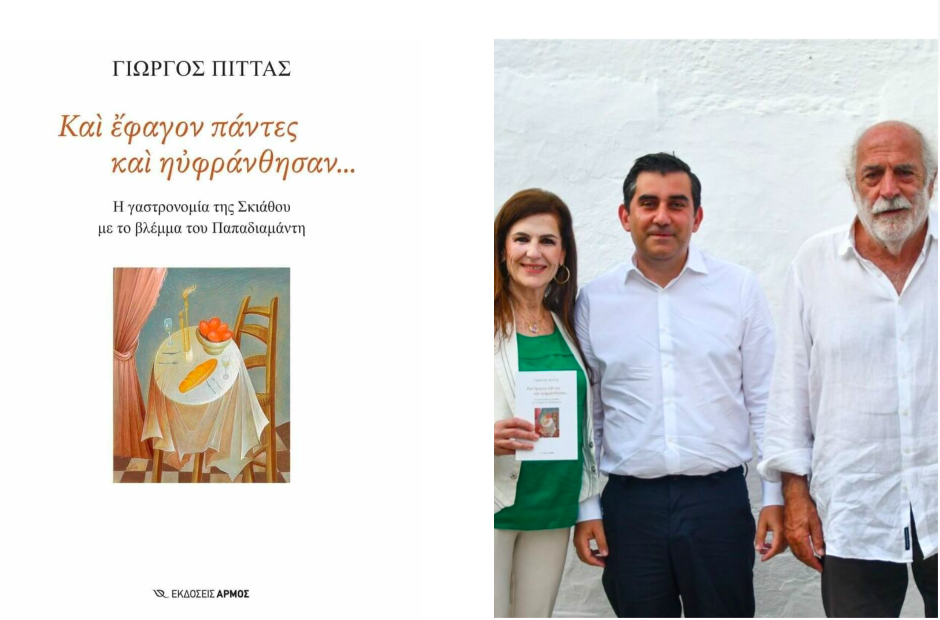
Day 1
Upon disembarking, the first sight is the verdant Bourtzi peninsula, a landmark separating the New Port from the Old Port. Bourtzi features a structure designed by architect Ernestos Tsiller, originally housing Skiathos’ first Primary School in 1903, thanks to a donation by Andreas Syngros. In the early 1980s, it transformed into a Cultural Center and Maritime Museum, honoring the island’s rich maritime heritage. If none of this excites you, simply relax amidst the breathtaking view under the cool pine trees.
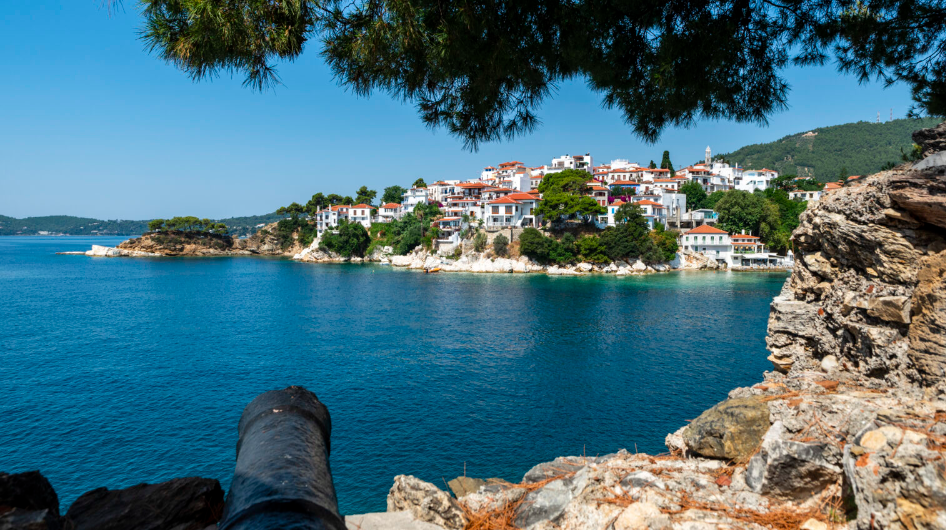

To the right lies the Old Port and Plakes district with its captains’ houses, straight ahead are the islets of Tsougrias—both small and large—and to the left is the New Port and Pounta Peninsula.
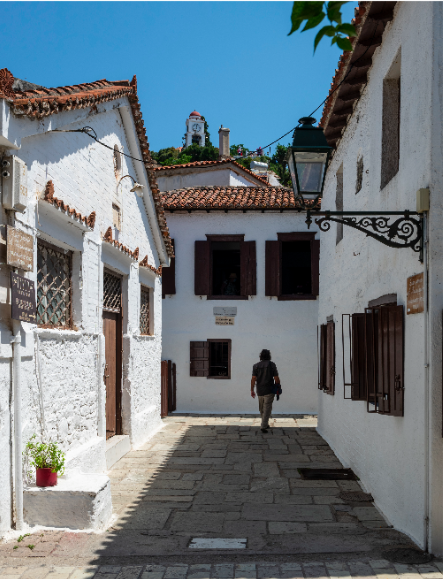
The pine trees create a wonderful atmosphere, transporting you to another place entirely. The all-day Bourtzi restaurant, developed amphitheatrically, offers meticulously prepared international cuisine, and appetizers showcasing typical Greek ingredients with hints of Middle Eastern flavors, all in a warm, inviting ambiance. Enjoy ceviche and tartar, sourdough bruschetta topped with Greek delicacies Products and delicacies from Middle Eastern cuisine served with a friendly, familiar disposition. Ceviche and tartare, pre-baked bruschetta with Grevena cheese, tomato, caper, and oregano, amazing taramasalata (the secret lies in the carob rusks), muhammara, spicy cheese spread, and fluffy pita bread sprinkled with Za’atar, white fish ceviche with kumquat, Halapeño pickles, and tuna tartare with cucumber, lime zest, and dill (Tel: 2427023900). Descending a few steps, you can take a dip in the green waters while washing your hands at the outdoor sinks, enjoying a picturesque view across the bay, Punta.
Leaving Chora, head northeast on the Peripheral Road towards Parissis Winery, the island’s sole winery. As you drive through the picturesque inland forest of pines, oaks, argios, and dense scrub vegetation, you’re greeted by a charming introduction to the journey ahead. Upon reaching the beautiful green hill of Prophet Ilias, standing at an altitude of 365 meters—the highest point in Skiathos—you’ll find the winery. The view overlooking Chora is breathtaking, especially during sunset, creating a truly romantic atmosphere where international visitors can savor the wines.
Founded by Yiannis Parisis and his wife Maria Koutseris in 2019, Parissis Winery reflects their passion and dedication. Today, their efforts have flourished, boasting 40 acres of dry vineyards cultivating Greek varieties such as Roditis, Assyrtiko, Malagouzia, Moschato of Alexandria, Xinomavro, and Limnio. Producing 20,000 bottles annually across five labels (including three whites, one rosé, and one red), their Malagouzia and the label of the dry red wine VAPORI are particularly noteworthy. Visits are by appointment only (Tel: 6987728440).
As evening descends, make your way down to the eastern beach in the Ammoudia area, at the end of the marina, for a seafood feast at Skouna restaurant. Situated literally on the sea, with a schooner converted into a bar, you can watch the kitchen’s bustling activity through the window. Enjoy lounge music in a sophisticated setting, indulging in specialties like taramo salad with smoked mackerel and turmeric, barley with prawns, sautéed sea bass with celeriac puree, pot veal with feta foam, and a decadent rice pudding with caramel foam for dessert (Tel: 2427 022185).
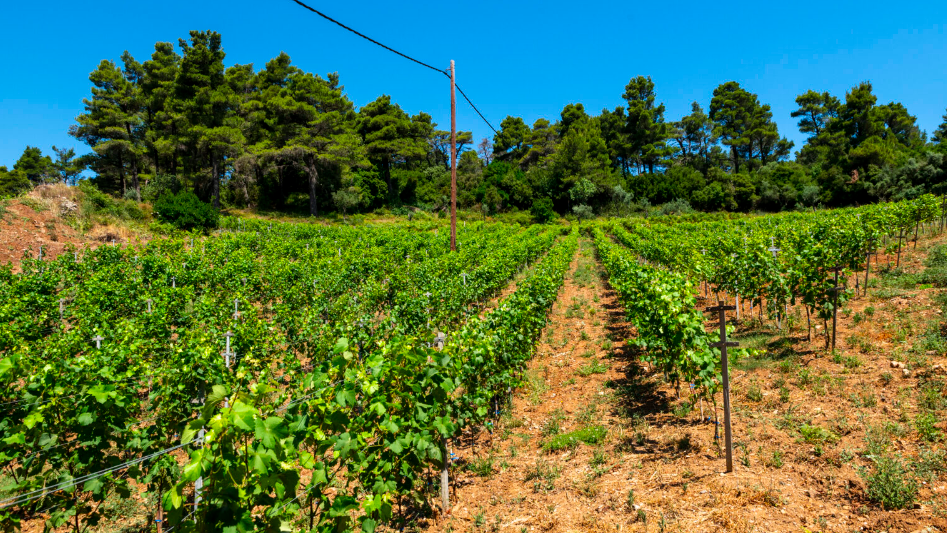
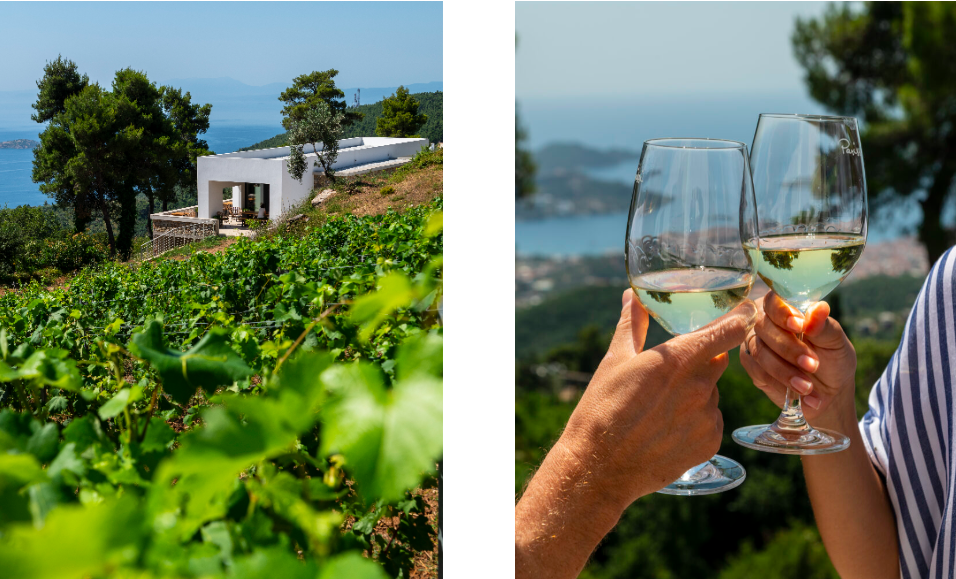
Day 2 was defined by our visit to the Castle in the northern part of the island. Following the footsteps of Papadiamantis and his unique talent as described in “Christ at the Castle” from his Christmas stories, we traversed the lush green inland area, passing through aesthetic forests and olive groves. The journey started on asphalt, which soon turned into a well-paved narrow road that our car handled with ease, still echoing the power of medieval times. We parked in the open space outside the Castle gates.
Reading about this unique place, even through Papadiamantis’s words of it being “built on a sea-facing high rock,” was one thing; seeing it in person was entirely another. Perched on cliffs that surround it on three sides, reaching heights of 200 meters, the Castle’s only entrance is through its Gate, accessed after crossing a bridge over a void. Below and around, the sea, cliffs, and sky framed its dramatic setting. From 1350 until 1829, up to 1,500 people lived here densely packed, fearing raids from Turks, Venetians, Algerians, and pirates alike. This year, after a study by the municipality of Skiathos, the bridge and its surroundings, including the stone path to the beach, were restored, and set to open to the public by late July.
Inside the Castle, we marveled at the beautiful Church of Christ’s Nativity, dating back to the 17th century, with its stunning iconography and ethereal light. Restoration efforts await the churches of Panagia Prekla, Panagia Megalomata, Agios Nikolaos, the mosque, and the maintenance of the old paved settlement. A stroll around the area offered views of Mount Pelion to the east, Skopelos to the west, and, on clear days, Mount Athos to the north. The coastline, adorned with wild cliffs, resonated with Papadiamantis’s description of “the sea-facing rock where the winds gather.” Passing by Fonnissa, now known for its melancholic reference in Papadiamantis’s work, we reflected on its poignant history.
Descending from the path to the sea, we arrived at the Beach of the Castle, where a small boat awaited us to transport us to Diamond Beach in the Kalamaki area for a meal. Visitors can rent their small boat from the Old Port or opt for a sea taxi, offering flexibility in exploring the island’s coastline. Our journey northeast revealed scenic spots like the whitewashed Lalaria Beach, the Cave of Fonissa, and Lechuni, significant for its historical associations under the Monastery of the Annunciation. We passed by the Great Bay, vividly described by Papadiamantis in “Dream on the Wave,” and the nearby airport known for its thrilling takeoffs and landings.
Continuing along the peninsula of Pounta, we skirted islands like Aspronisos, Arkos, Repi, and Maragko before finally reaching Diamond Beach in Kalamaki. This newfound gem boasted sapphire waters and hosted a beach bar restaurant named “Diamond,” set amphitheatrically on the sand with tables shaded by grassy awnings, balconies for relaxation, and a well-stocked bar. The dishes, some echoing Papadiamantis’s descriptions, delighted our palates with specialties like shrimp in tomato sauce with zucchini, a typical Skopelos seafood and vegetable combination, and freshly grilled fish with local greens. The restaurant, owned by the charming Katerina Chouma and her mother in the kitchen, exuded an atmosphere of pure joy.
After soaking in the ambiance, enjoying drinks, swimming, and basking in the sun, we reluctantly departed for Town, salty and sun-kissed. We gathered at Papadiamantis Square to attend George Pittas’s captivating book presentation. Before the event, some of us relaxed over coffee at the nearby café “Nostalgos,” while others savored Papadiamantis’s preferred brew accompanied by olives.

Dinner unfolded at “Amphilyki,” where Christos Kalogiannis’s wife and sister prepared exquisite local dishes featuring vegetables and herbs unique to the region. Highlights included shrimp with zucchini and tomato, fennel meatballs, stuffed sfigra with tomato, and flavorful stewed fish. For those inclined towards traditional tastes, marinated bream with garlic and tsitsiravla or lamb with garlic and rosemary were available, complemented by an ethereal moussaka featuring grilled eggplants. Fresh wild greens sourced from their garden added a local touch to our meal, enjoyed against a stunning backdrop that included views of Evia, Choungria, and Arkos.
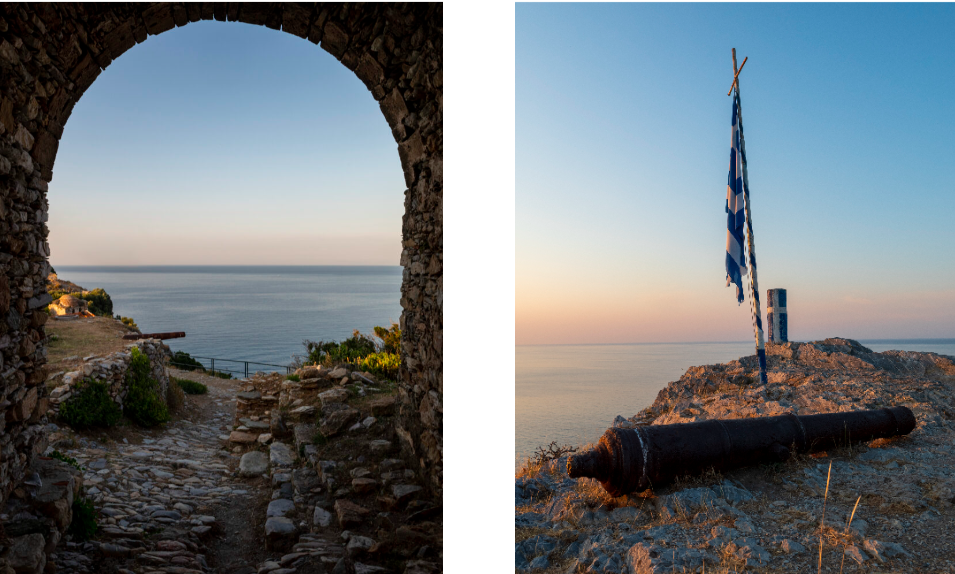
Our second day on Skiathos Island concluded with a satisfying meal, leaving us eagerly anticipating the adventures that lay ahead.
Day 3 is dedicated to a vibrant cultural tour. Our starting point is the Monastery of Evangelistria in the northeast, a place doubly consecrated to the Annunciation and the Dormition of the Virgin Mary. Founded amidst conflict among the monks of Mount Athos, who sought a return to traditional practices while rejecting certain innovations, the monastery’s establishment in 1794 began on the lush banks of Agallianos Creek, where an ancient ruined chapel stood, completed in 1806. Greenery, tranquility, and beautifully arranged flowers greeted us in its courtyard.
The monastery’s architecture is Byzantine, with a cruciform plan and a dome. Entry into the courtyard is through a passage flanked by two enormous cypress trees adorned with ivy and bougainvillea, their voices whispering tales of antiquity. The monastic refectory, styled in Athonite tradition, includes an ambo where sacred texts are read aloud during meals. An impressive kitchen features a large cauldron and a towering chimney that extends beyond the roofline of the building. The monastery also houses a museum with treasures, including a replica of Greece’s first flag from the 1821 War of Independence and a remarkable Cretan School icon depicting the Descent from the Cross. During our visit, the esteemed Abbot of Monastery Joseph shared an intriguing detail: the Kolivades monks introduced the “Soul Saturdays” with koliva, hence their colloquial nickname by opposing monks.
Our second fascinating stop was the Skiathos House in Chora. This family home of the Manesis-Konstantinidis family has captured their lives since 1835, when they descended from the Castle until recently. It felt like stepping through the decades and centuries with an open book before us, illustrated with a phonograph brought by expatriates, a hand-knitted baby blanket bearing the embroidered name of the newborn to “capture” the name, and the varied attire of women: white kolvoli (outer dress) for unmarried, red for married, and black for widows. A striking detail was how, in times of mourning, families painted their curtains and shutters black or mauve.
We also visited the fascinating Reborn Project Gallery Art House Skiathos by artist Kostis Zohas, where wood and object components were ingeniously repurposed to breathe new life into art pieces alongside works by other artists from different locales.
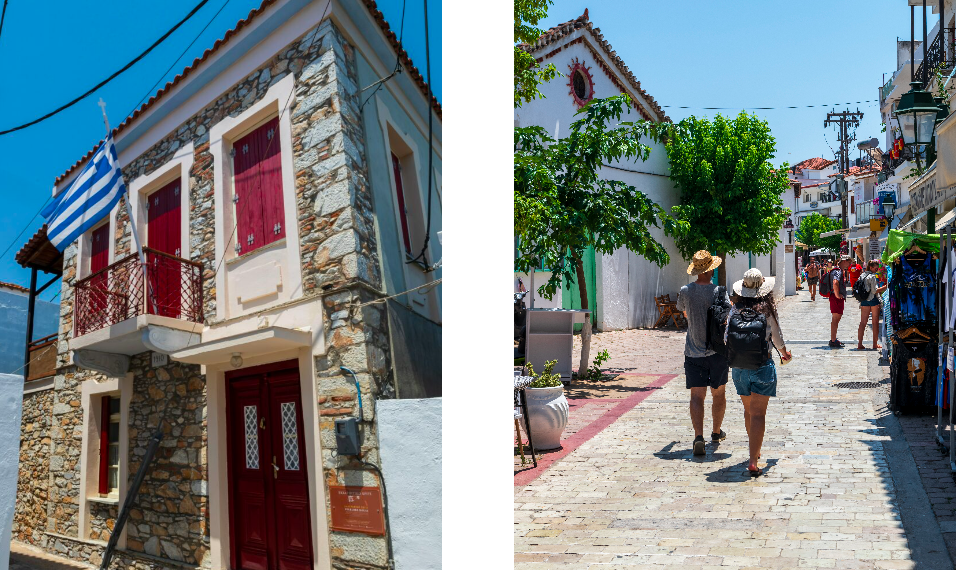
The House of Papadiamantis, a two-story, modest dwelling with its narrow bed, photographs, and artifacts, stands as a museum dedicated to the great, humble island writer. Located on the bustling main street that bears his name, one wonders how he would comment if he were alive today, he who loved people with their vulnerabilities enough to stay away from them. The home of the writer and poet Zissis Economou, of the ’30s generation, who was born the year Papadiamantis passed away, was a revelation. It has been transformed into a digital museum, offering guided tours in eleven languages.
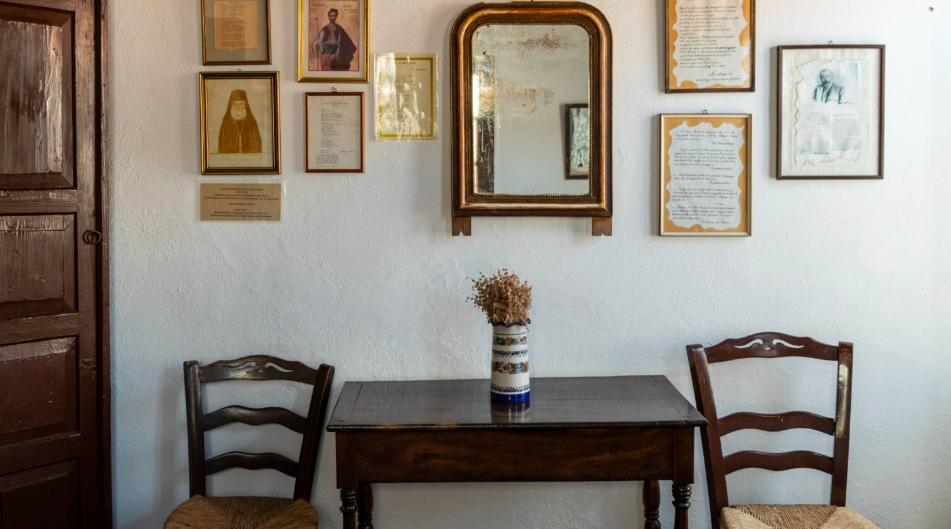
Returning to Bourtzi for a delicious meal and coffee, we awaited the boat that would ferry us to Mandoudi if we hadn’t arrived by plane. The forested Skiathos, with its 60 stunning beaches, presented us with some of its most beautiful moments.
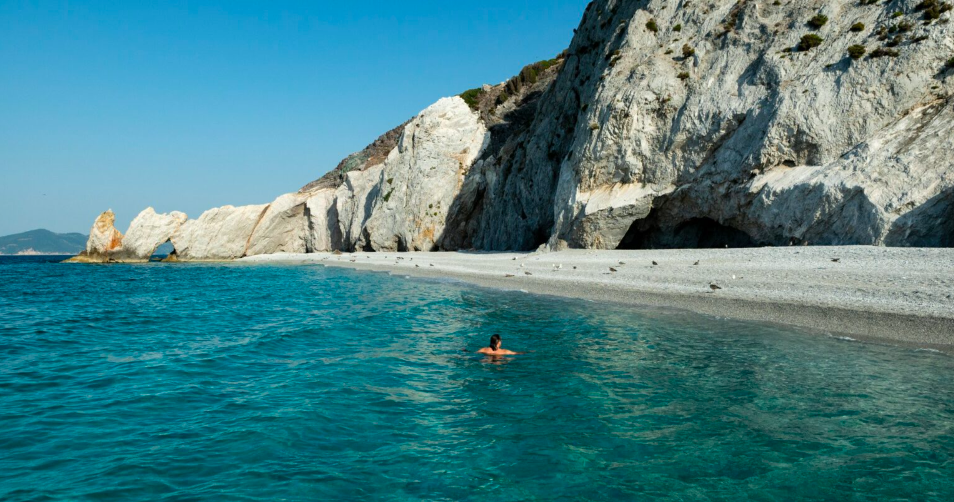
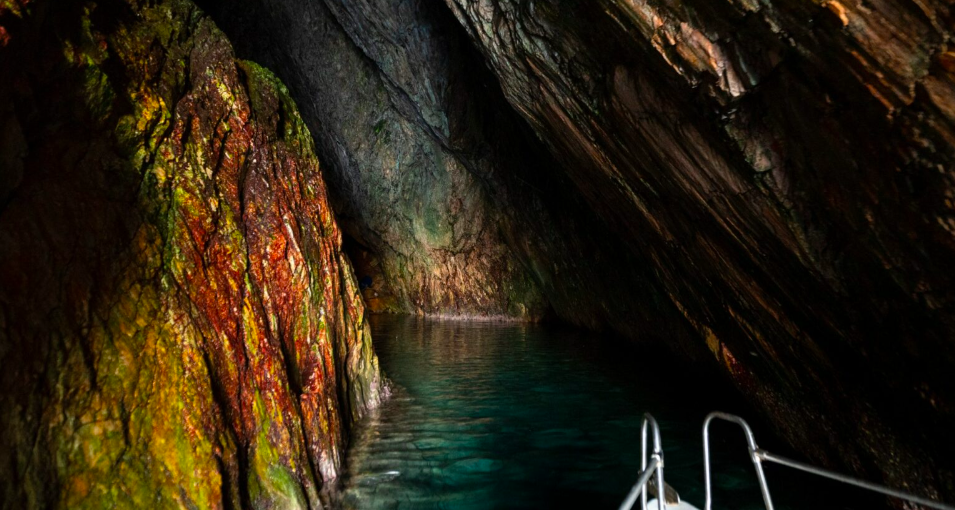
Ask me anything
Explore related questions
